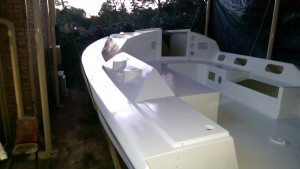It took a day and a bit to sand the first two pack polyurethane undercoat to my satisfaction and half a day to put on the second coat. Painting the deck and cabin is a lot more difficult than painting the hull. For a start the hull was fully fibreglassed and then bogged and filled where required. Then a sandable primer was applied to the round bilges to take our the last fraction of a millimeter bumps. Then there are all the angles and corners to do.
Only the Interprotect two pack epoxy primer has been used on the deck as much of it will be covered in non skid which will hide the small imperfections. Martin says that the high gloss of the finish on the cabin sides will reflect the light and any small deviations will not be noticed. The gunwales which are a pretty solid construction have sanded up well and after two coats of undercoat I am confident that I will be happy with the finish gloss on those bits.
I did a better job of applying the second coat of undercoat but there are still a few runs which will have to be sanded out before I can apply the top coats. The top coats will be a two stage affair with the glossy bits completed first and the non skid areas done one at a time. I will have to let the glossy bits cure enough to take masking tape for the non skid areas. I am keen to get the non skid on the deck for obvious reasons.
To protect the deck from flying debris I raised a second tarpaulin along the long side of the awning and now the hull is protected on three sides. With this added protection finishing the topsides should be easy.


